
|
Sale 36
Pre-Long Beach Coin and Currency Auction
| Lot |
Photo |
Description |
Realized |
Lot 3098 |
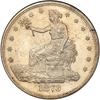 |
1873 Trade Dollar. NGC graded MS-64. Well struck and lightly toned. Smooth but frosty luster, the coin gently toned to a light milky haze through which intense silver color still persists. A blunt impression is often left by the recoil of the dies that struck this first year's coinage; just the same, we can report that this specimen, unlike the others, is outstanding in its detail and sharpness at the stars and Liberty, all letters and especially the eagle's body and wings. Pop 24; 7 in 65; 3 in 66.
Estimated Value $3,500 - 3,800.
View details and enlarged photos
| Realized
$4,600 |
Lot 3099 |
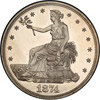 |
1874 Trade Dollar. PCGS graded Proof 64 Cameo. A sparkling white coin. Only 700 proofs struck. A boldly struck white-surface coin whose high-end depth of detail in the strike complements the equally fresh mint bloom. In light of that, we can also say this piece is as nicely struck as any Gem would be, with extremely full details on both sides. Only a few trace hairlines limit its grade to Proof 64 and not something higher.
Apparently, most of the Proof trade dollars were sold as part of 1874 silver Proof sets, and deliveries by months match other silver Proof coins of the year. Bowers explains further, in the trade dollar section of his silver dollar encyclopedia: "Although 700 may have been distributed to numismatists, the rate of retaining them was not high, and today hundreds of pieces have been lost. These pieces were simply spent for face value, as was also the case for many 1873 Proofs-accounting for the impaired Proofs occasionally seen today. On the numismatic market the 1874 Proof is very undervalued." (PCGS # 87054) .
Estimated Value $4,000 - 5,000.
View details and enlarged photos
Check results on similar lots
| Realized
$6,900 |
Lot 3100 |
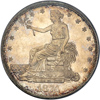 |
1874-CC Trade Dollar. PCGS graded MS-63. Nice golden toning. A glistening MS63 of this scarce CC-mint date with luster that practically flies off the surface. A few light bagmarks, but nothing special. Subtle hints of russet and gray with other toning bring out the extra sharpness of the strike while it enhances the unexpectedly beautiful eye appeal of this frosty coin. Pop 34; 13 in 64; 1 in 65, 1 in 66. (PCGS # 7035) .
Estimated Value $5,000 - 5,500.
View details and enlarged photos
Check results on similar lots
| Realized
$5,750 |
Lot 3101 |
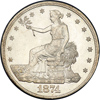 |
1874-S Trade Dollar. PCGS graded MS-64. Nice untoned coin. Frosty white patina dominates both sides with characteristic San Francisco mint high quality and swirling luster. If anything, this is a bit nicer than average for the MS64 designation, surely in line with many specimens housed in "name" collections of the past or under current construction by smart buyers. Pop 22; 1 finer in 65. (PCGS # 7036) .
Estimated Value $4,500 - 4,800.
View details and enlarged photos
Check results on similar lots
| Realized
$6,038 |
Lot 3102 |
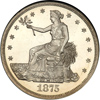 |
1875 Trade Dollar. NGC graded Proof 65 Cameo. Well struck and white. From one side to the other the luminous silvery luster glows with firebolt brilliance in the mirror fields and from the bold frosted white devices. Another beautiful trade dollar, this too, displays a precision strike on the legends and main device, which is always appreciated for the date, and not even a trace of soft detail at the head, stars, or eagle's wing.
Opinion has it that 700 Proofs were made, but there is a strong case that the quantity might have been 900, according to the Bowers encyclopedia. Proof coinage commenced with 300 pieces in January, after which no pieces were made in February. In March 200 Proofs followed. By the end of September the total was 700 (or 900), apparently more than enough, as no more followed. Pop 13; 1 in 65 Cameo Star; 4 in 66 Cameo.
Estimated Value $7,500 - 8,500.
View details and enlarged photos
| Unsold |
Lot 3103 |
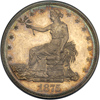 |
1875 Trade Dollar. PCGS graded Proof 63. Old green holder. Lovely light golden toning. Pop 60; 69 finer. An attractive choice Proof 63 Trade dollar whose nice mirrors and frosted relief lie under several fine layers of toning. The deepest color resides at the rim on both sides. What's more, this piece is agreeably well struck to say the least, indeed not fully so, enough to merit reference here (PCGS # 7055) .
Estimated Value $1,900 - 2,100.
View details and enlarged photos
Check results on similar lots
| Realized
$6,038 |
Lot 3104 |
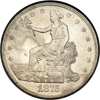 |
1875-S Trade Dollar. NGC graded MS-64. Frosty white with a hint of tone starting to form. A gleaming fresh gem like several other Trade dollars from this consignor, with strong underlying luster and sharp highlights on both sides. In fact, other than for a few stars near the top of the obverse, every devices is nicely struck for the date, more fully so than average, and certainly a coin that gets nods of approval where fullness of design is an important consideration. Pop 123; 34 in 65; 4 in 66.
Estimated Value $3,000 - 3,200.
View details and enlarged photos
| Unsold |
Lot 3105 |
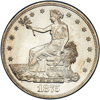 |
1875-S Trade Dollar. PCGS graded MS-64. Well struck and white. A blazing beauty of a 1875-S Trade dollar! The satiny surfaces are alight with swirling, volatile cartwheel luster that looks as though it would like nothing better than to spin into a great big white tornado vortex and then burst forth with a loud bang. Well struck for the date and easily matching or surpassing others in this condition. If someone were to ask, "but aren't there any marks", we'd reply, yes, there are, but only a few: a faint thread-like lint mark near the 8th star and two little chattermarks in the field by stars 12 and 13, nothing more than you might find in any other carefully preserved Trade dollar in MS64 condition. Except that is the problem. There are very few other attractive 1875-S Trade dollars like this. Pop 155; 31 finer. (PCGS # 7039) .
Estimated Value $3,000 - 3,200.
Ex: daniel B Biddle.
View details and enlarged photos
Check results on similar lots
| Unsold |
Lot 3106 |
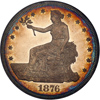 |
1876 Trade Dollar. NGC graded Proof 64 Cameo Star. Beautiful light gold toning with light blue colors around the edges. Wonderful eye appeal. The present specimen displays smooth, original surfaces that would settle for nothing less than a full Gem grade were it not for a few very trivial hidden hairlines. Quite scarce above the Proof 64 level. No more, no less, just as fully struck, as attractive, as you could ask for, with complete detail at the stars, centers, and on all letters in the legends.
The Proof coinage for this year amounted to 1,150 coins according to Mint records, with little doubt among specialists as to the accuracy of this figure. 1876 was the year that the Centennial Exhibition was held in Fairmount Park in Philadelphia to observe the 100th anniversary of American independence. The Mint was invited to set up a display of coins and a sales facility there, but declined, stating that visitors were welcome to come to the Mint itself. Evidently many did. Pop 1; 11 finer.
Estimated Value $5,000 - 6,000.
View details and enlarged photos
| Realized
$8,050 |
Lot 3107 |
 |
1876-CC Trade Dollar. MS-60. Prooflike. Lightly toned to a nice shade of russet to medium russet and neutral silver-gray. Boldly struck devices are presentably illustrated on this handsome piece. The stars and all of Liberty's gown folds, nicely captured by the full strike of the dies. The top curve of one wing on the eagle is lightly rounded, as is the leg opposite, but the remaining feathers are very bold. An attractive Trade dollar.
Estimated Value $2,000 - 2,500.
View details and enlarged photos
| Realized
$2,400 |
Lot 3108 |
 |
1876-S Trade Dollar. PCGS graded MS-64. Nice golden toning. A glistening beauty and a fresh toned specimen by any standards. This piece has an engaging display of lively iridescence that spread across the highly lustrous silver gray surfaces without any major impairment. The strike is strong for the date, as well, including the stars and not overlooking a first-rate eagle, to boot. Pop 86; 5 in 65; 1 in 66. (PCGS # 7043) .
Estimated Value $2,700 - 2,900.
View details and enlarged photos
Check results on similar lots
| Realized
$3,450 |
Lot 3109 |
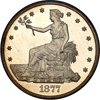 |
1877 Trade Dollar. PCGS graded Proof 65 Deep Cameo. Fully white and well struck.A glowing icy freshness is emitted from undisturbed original surfaces on this immensely beautiful Gem Proof 1877 trade dollar. Judged merely from an aesthetic standpoint, and not counting the rarity, the coin is also possessed of a much finer strike than is typically found for one of these, with splendid surfaces as well.
While monthly reports of Mint production figures for Proofs suggest a total mintage of 510, some (including Walter H. Breen and Q. David Bowers) have questioned this figure. Based upon the number of known specimens, and the 200 made in February (before any major deliveries of business strikes), "a figure of 710 seems more likely," suggests Bowers in his silver dollar encyclopedia. Proofs, though rare in the overall context of numismatics, are not among the rarities of the 1873-1883 Proof series. But the specialist will want to take care not to overlook this relatively low population Gem Proof 65 with its cameo devices. Pop 2; none higher at PCGS in DCAM. Only 6 graded at PCGS in DCAM for this date. (PCGS # 97057) .
Estimated Value $9,000 - 11,000.
View details and enlarged photos
Check results on similar lots
| Unsold |
Lot 3110 |
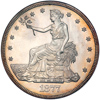 |
1877 Trade Dollar. NGC graded Proof 63. A hint of light gold toning. A satin-fresh beauty with the devices providing light but still visible contrast against the rolling mirrors in the level Proof field. The silvery color includes splashes of rich gold at the rim which extends partway toward the central design. Here and there some hairlines. But nowhere is there any weakness in the consistently sharp relief. A wonderful chocie fresh coin. Only 510 proofs minted. Pop 38; 74 finer.
Estimated Value $1,400 - 1,500.
View details and enlarged photos
| Realized
$2,588 |
Lot 3111 |
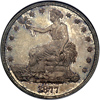 |
1877-S Trade Dollar. NGC graded MS-65. Light original grey toning on both sides. Pop 30; 3 in 66; 1 in 66 Star; 1 in 67. A hard to believe array of rich gray to steel blue hues dapples the surfaces of this handsome gem San Francisco mint Trade dollar. A small mark in the field is seen at the last star on the obverse, with a short hairline scratch beside the 10th star, but the present prize is still extraordinarily beautiful. What one sees sometimes on this mint's coinage is an unconvincing impression left after the recoil of the dies; greatly to our pleasure and the bidders', that is not the case here. This Gem MS65 is sharp, very sharp, in fact.
Estimated Value $6,000 - 7,000.
View details and enlarged photos
| Unsold |
Lot 3112 |
 |
1877-S Trade Dollar. PCGS graded MS-65. Lovely toning on both sides. Both the peripheries and the central areas are impressive for their sharpness of mint frostiness, and the smooth textured surfaces are glistening as well as almost entirely free of the usual bagmarks. About as fully struck as these are normally found, also, with just terrific detail in the stars and Liberty's hair, body, and agricultural regalia she is using as a perch to gaze over her seaside domain. There is no sailing ship off in the distance, but on a Pattern twenty-cent coin of similar design, this was indeed the intention of the design (William Barber) who placed a tiny sailing ship just above Liberty's feet. The devices was never placed on the circulating Trade dollars, however. Pop 21; 5 in 66; 1 in 67. (PCGS # 7046) .
Estimated Value $6,000 - 7,000.
View details and enlarged photos
Check results on similar lots
| Realized
$8,625 |
Lot 3113 |
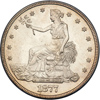 |
1877-S Trade Dollar. PCGS graded MS-64. Well struck. Cartwheel luster dances upon the satiny, matte-like surfaces of this attractively toned 1877-S Trade dollar. A blend of satiny to nice mint frost over both sides. The strike is somewhat soft on the reverse on many of these, though the design elements here show unusual sharpness and character far in advance of what most collectors expect. Pop 135; 21 in 65; 5 in 66; 1 in 67. (PCGS # 7046) .
Estimated Value $3,100 - 3,300.
View details and enlarged photos
Check results on similar lots
| Unsold |
Lot 3114 |
 |
1877-S Trade Dollar. PCGS graded MS-63. A hint of light golden toning. A sparkling MS63 with choice, fresh underlying luster that breathes fiery life into the attractively toned highlights. Well struck with crisp details aplenty. Only a few stray bagmarks. Pop 155; 162 finer. (PCGS # 7046) .
Estimated Value $2,000 - 2,100.
View details and enlarged photos
Check results on similar lots
| Unsold |
Lot 3115 |
 |
1878 Trade Dollar. PCGS graded Proof 66 Cameo. Lovely golden to amber red and brown toning with a little steel blue sparkle at the extreme margin. Only 900 minted all as proofs. Lightly toned, yet basically pristine in appearance. The few wispy hairlines require magnification to pick out, and obviously do not detract from the overall pleasing eye appeal of this stellar Gem. Pop 4; 1 in 67 CAM. (PCGS # 87058) .
Estimated Value $10,000 - 12,000.
View details and enlarged photos
Check results on similar lots
| Realized
$17,825 |
Lot 3116 |
 |
1878 Trade Dollar. NGC graded Proof 65 Cameo. Fully white coin. Only 900 proofs minted for this proof only date. From one end to the other the intense silvery luster gyrates with almost atomic intensity in the deeply reflective mirrors and bold cameo devices. Where an ineffectual imprint is now and then left after the dies retract, the opposite is in fact the case here: devices show crystal clarity and wonderful detail in the centers, on the stars, and at all of the legends. Bidders be advised, you may face stiff competition.
On February 22, 1878, Secretary of the Treasury John Sherman, a foe of the trade dollar denomination, mandated that coinage cease. By this time Philadelphia had produced no business strikes, and made none later, only Proofs. Carson City had made some, production was halted there, and many extant coins were melted. San Francisco ended its coinage, but not immediately, as it wanted to take care of pending business and deposits. Mintage at Philadelphia in 1878 was limited to Proofs, as mentioned above, and occurred in only four months: January 300, February 200, March 200, and May 200. Proof 1878 trade dollars were sold in sets; later issues, 1879-1883, were sold as singles.
Some remained unsold: by early 1879 there were 219 unsold 1878-dated Proofs on hand. These were distributed, presumably for bullion value or possibly face value, probably to coin dealers. The official Mint issue price for Proof trade dollars from 1878 to 1883 was $1.025 each, according to one account, because the coin had been demonetized; most other sources give the figure as $1.25 each, a figure with which coin historian R. W. Julian agrees. Pop 13; 4 finer at NGC.
Estimated Value $7,500 - 8,500.
View details and enlarged photos
| Unsold |
Lot 3117 |
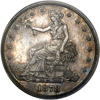 |
1878 Trade Dollar. PCGS graded Proof 63. Grey toning with a little blue toning on both sides. Only 900 proofs struck for this proof only year. An thick array of natural shades of "old silver" supports steel colored toning and some iridescent highlights. Nicely struck for the issue although not as attractive as some. Pop 82; 84 finer. (PCGS # 7058) .
Estimated Value $2,000 - 2,300.
View details and enlarged photos
Check results on similar lots
| Realized
$2,185 |
Lot 3118 |
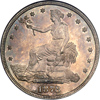 |
1878-S Trade Dollar. NGC graded MS-65. Well struck with nice even original toning. Pop 25; 17 in 66; none finer at NGC. Beautifully toned, this coin is, and lustrous as well, with just a whisper of blue in the mostly "old silver" to light purple-gray toning. A truly marvelous Gem trade dollar for type set purposes, not a rare year but in terms of overall quality, quite elusive. Notably, all of the obverse stars, the head of Liberty, and other features are crisp, while on the reverse, the eagle is minutely detailed. Obviously the consignor of this piece very selective (and also very lucky to find it) and it now belongs to the highest bidder. Who will that be?
The Trade dollar is by the Philadelphia mint's Chief Engraver, William Barber. Liberty sits on a bale of cotton and scans the horizon across the sea to the west, to China, figuratively, since this was the intent of such pieces, to be used as silver trade coins to compete with the Mexican 8 reales. The reverse has an eagle of a new style lacking a shield on its breast for the first time, with the mandated inscriptions including the fineness, another first for what was then a legal tender coin.
Estimated Value $5,000 - 5,500.
View details and enlarged photos
| Realized
$5,750 |
Lot 3119 |
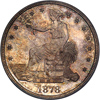 |
1878-S Trade Dollar. PCGS graded MS-64. Attractively toned. Semi prooflike surfaces. Pop 64; 42 finer. An very fresh and lustrous specimen that comes close to gem 65 quality, and one bidders may choose to set as a yardstick for other examples that share this grade. While the strike is forthright and crisp, it is more than reasonably full, and includes sharp head and body details on both Liberty and the eagle, plus crisp clear stars (PCGS # 7048) .
Estimated Value $2,400 - 2,500.
View details and enlarged photos
Check results on similar lots
| Realized
$3,335 |
Lot 3120 |
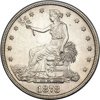 |
1878-S Trade Dollar. PCGS graded MS-63. Untoned. An accurately graded MS63 which has the blush of snow on its crisp white surfaces, fields and devices glistening with full, frosty textured luster and only a few light marks or hairlines putting a roadblock in the way of a higher grade. Production halt delayed: By February 22, 1878, when Secretary of the Treasury John Sherman halted trade dollar mintage, the San Francisco Mint had already made 1,695,819 pieces. This branch did not end production until early April; by then the total was 4,162,000, nearly a record production (the fourth highest in the series).
By the time that the last 1878-S trade dollar fell from the dies, coins of this denomination valued at over $36 million had been produced, a munificent sum in those days, although peanuts in today's trillion-dollar world; just the same, that was an amount over four times greater than all of the silver dollars that had been coined from 1794 until the denomination was suspended in 1873. Of course, hundreds of thousands of Trade dollars were later returned to the Treasury and melted. Pop 86; 107 finer. (PCGS # 7048) .
Estimated Value $1,800 - 1,900.
View details and enlarged photos
Check results on similar lots
| Realized
$1,955 |
Lot 3121 |
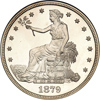 |
1879 Trade Dollar. NGC graded Proof 67 Cameo. Fully white and choice. Only 1,541 struck for this proof only date. Without doubt the most visually stunning feature of this coin is its soft, frosted mint luster on the devices, causing the raised areas to appear as floating islands upon the glassy smooth mirror field. Full glittering luster on both sides, in fact, and downright superb in its brilliance. Of course, collectors seeing the photos understand this coin is nicely struck for the date, best of all entirely so. Certainly a coin that gets proper mention where completeness of design is always admired in a high-end Proof. Pop 13; 7 finer at NGC.
Estimated Value $15,000 - 17,000.
View details and enlarged photos
| Unsold |
Lot 3122 |
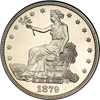 |
1879 Trade Dollar. NGC graded Proof 66 Cameo. Fully white proof trade dollar. Only 1541 proofs minted for this proof only year. Pop 17; 22 finer. Fully radiant -- an important and rare feature for this not all that well preserved issue -- the surfaces display metallic pearl-white "depth" in the mirrors whose pulsating sparkle is almost unnerving to view. All devices are cameo frosted. If you were expecting the design left by the dies to be deficient in robustness, take heart, since this is an exceptional coin and not the usual run-of-the-mill Proof strike. It is, indeed, very bold.
Production of Trade Dollars was limited to Proofs this year: No more business strikes were coined. (In their place, the various mints were striking enormous quantities of Morgan dollars, unacceptable in China, circulating little in the United States, and mostly stored in bank vaults and the Treasury.)
Curiously, when word got around there would be no more three-cent pieces, gold dollars, $3 gold pieces, and no more circulation strike Trade Dollars, there arose in 1879, and continued into 1880, a popular numismatic speculation (later extended to the general public). Word spread that certain coins were of low mintage and would become rare. The "best" condition was considered to be Proofs (business strikes were generally ignored and, in any event, were not available in this series). Emphasis was on inexpensive nickel three-cent pieces and shield nickels, but also focused on Trade Dollars, all of which were minted in record Proof numbers in 1879. A heightened interest developed in other Mint products as well, which is why there is such a large number of 1879 Patterns. Several years later this speculation would extend to regular issue Proof and business strike gold dollars as well as $3 gold.
The fever to salt away Proof Trade Dollars did not develop until the end of 1879, as the monthly Proof production figures show: January: 122; February: 96; March: 75; April: 119; May: 90; June: 140; July: 40; August: 45; September: 89; October: 64; November: 80; and, finally, December with a whopping 581.
Estimated Value $10,000 - 11,000.
View details and enlarged photos
| Unsold |
Lot 3123 |
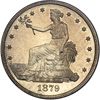 |
1879 Trade Dollar. PCGS graded Proof 64 Cameo. Mostly untoned with a hint of gold color on the obverse. Only 1541 proofs minted for this proof only year. Nice bold strike. This is an extremely fine-looking Trade dollar, a coin with outstanding luster, strong contrast, and a wallop from the dies that is amazingly close to perfect for a coin of this year. Attractive toning suggests that the present specimen spent much of its life in an old style coin envelope or album or similar protective container. Pop 25; 21 finer in Proof Cameo at PCGS. (PCGS # 87059) .
Estimated Value $4,000 - 4,500.
View details and enlarged photos
Check results on similar lots
| Realized
$3,910 |
Lot 3124 |
 |
1879 Trade Dollar. PCGS graded Proof 64. Lovely light gold and blue toning. Well Struck. Only 1541 proofs minted for this proof only year. An astonishing Proof 64 that many will think belongs in a Proof 65 holder, one of the best possible order whose satiny frosted devices play host to robust surrounding mirrors. Pop 110; 65 finer in proof at PCGS. (PCGS # 7059) .
Estimated Value $3,500 - 3,800.
View details and enlarged photos
Check results on similar lots
| Realized
$3,795 |
Lot 3125 |
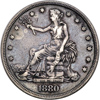 |
1880 Trade Dollar. EF-40. Only 1,987 pieces struck for the year. Scarce in this grade, a Proof that was spent. The fact this shows the amount of circulation wear that it does, proves that in spite of all the negative comments about how the circulation of Trade dollars harmed the working man the coins did find solid use in commerce.
Estimated Value $1,000 - 1,200.
View details and enlarged photos
| Realized
$1,121 |
Lot 3126 |
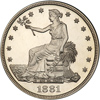 |
1881 Trade Dollar. NGC graded Proof 67 Cameo. A blazing white gem. Great eye appeal. Pop 8; 1 in 68; 2 in 68 Star. Swirling frosty luster on the devices is rounded by mirror glow in the fields, and comprises only one out this coin's list of memorable features. Both the peripheries and the central reverse are detailed and close to 100% crisp for their sharpness of strike, which is a forceful reminder in a Proof coin this year that it is quality that counts.
No business strikes made: As in all years 1879-1883, the only trade dollars made were Proofs. This year set a record for Proof trade dollar mintage on top of the earlier record set in 1879. During 1880 trade dollars of earlier dates continued to come back to the United States, primarily through the London and other European markets. But because of the increased speculation that we wrote about in the description of the 1879 trade dollar, Proof coinage continued to set a record: The popular speculation in Proof-only trade dollars continued and appears to have peaked in early 1880, as the following delivery figures indicate: January: none;' February: 488; March: 777; April: 201; May: 58; June: 50; July: 20; August: 25; September: 30; October: 27; November: 40; and December: 271. By year's end some 1,987 Proofs had left the coining press, a record for the denomination. Most of the 1880-dated Proofs still exist, perhaps 1,300 to 1,700 of the 1,987 coined. They are readily available in various grades from Proof-60 to Proof-64, but seldom seen in such superb quality as this lovely Cameo Proof 67!
Estimated Value $15,000 - 19,000.
View details and enlarged photos
| Unsold |
Lot 3127 |
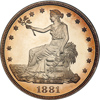 |
1881 Trade Dollar. NGC graded Proof 66 Cameo. Well struck and mostly white with some light golden toning around the edges. A Beauty! Only 960 proofs issued for this proof only year. Pop 10; 12 finer. Lustrous with dominant snow white frostiness on the devices and appealing warm golden brown peripheries. What a sensational trade dollar! Additionally, this date is easier said than done to find fully struck since often the stars or a portion of the eagle is weak. The centers pack full detail into the design from a decidedly precision strike as do the stars and legends.
Reflecting the dwindling fad for obtaining Proofs, mintage of 1881 trade dollars (all Proofs) was once again nearly equal to the number of silver Proof sets minted (960 trade dollars very scarce. 975 of other silver denominations). As before, during 1881 the influx of earlier-dated trade dollars from foreign countries, primarily London, continued. With speculation no longer a factor, by 1881, production of Proof trade dollars reverted to its normal level. Monthly figures are as follows: January: none; February: 300; March: 175; April: 85; May: 40; June: 70; July: none; August: 10; September: 25; October: 51; November: 38; and December: 166. The total for the year came to 960.
Estimated Value $10,000 - 11,000.
View details and enlarged photos
| Realized
$13,225 |
Lot 3128 |
 |
1882 Trade Dollar. NGC graded Proof 65 Ultra Cameo. Blazing white gem. Pop 3; 12 finer in Proof Ultra Cameo. The surfaces seem to dance from side to side with boiling silvery color, and quite lustrous. The combination of mirror surface plus frosted devices provide a nice, strong cameo effect on this Gem Proof. Sometimes on this issue, as in 1880 and 1881, the devices that were left by the dies are short of the required precision due to weak die pressure, but we find the opposite to be the case here, everything is finely detailed, including the centers, with only a few of the top stars needing attention as not quite up to snuff.
For the fifth year in a row, the only trade dollars minted at Philadelphia were Proofs. The mintage figure of 1,097 Proofs was nearly equal to the number (1,100) of silver Proof sets made of other denominations from the dime to the Morgan dollar. Earlier-dated trade dollars continued to flow into the United States from foreign countries, particularly Europe, causing laborers great stress and loss of purchasing power but enriching speculators who could buy up the demonetized circulated trade dollars at 80 to 85 cents apiece and sell them to companies for a nice profit. The companies forced their workers to take the coins in their pay envelopes. The workers then had to spend them at a discount below face value in stores (where they weren't wanted), suffering a measurable loss!
Back to the rare Proofs, by year's end of 1882, 1,097 Proofs had been struck, the third highest Proof mintage in the series, and one of just three Proof production quantities to break the 1,000 mark. Demand for them seems to have been heaviest earlier in the year.
Estimated Value $8,000 - 9,000.
View details and enlarged photos
| Unsold |
Lot 3129 |
 |
1883 Trade Dollar. PCGS graded Proof 66 Cameo. A blazing white gem. Pop 7; none higher at PCGS. This is a blemish-free case in point of the scarce 1883 trade dollar in this grade: sleek white in color, with mint bloom that captures the full effect of the careful preservation since it was made. In addition, the coin possesses a nice, clear-cut strike for all areas with outstanding detail at the cameo frosted devices on either side. A jewel!
As before, production was limited to Proofs in 1883: In this final year of public sales of trade dollars as singles as well as in the Proof sets. The figure of 979 Proof trade dollars fell short of the 1,039 Proofs made of other silver denominations. Horatio Burchard, who had been director of the Mint since February 1879 and who had replaced Dr. Henry R. Linderman in the post, considered the trade dollar to be a nuisance and an aggravation, even though business strikes were no longer being coined. In his annual report Burchard noted in part: "Probably from five to seven millions of these coins are now held in the country, mostly in the mining and manufacturing regions of Pennsylvania and contiguous states, and in the vicinity of New York, where they have been paid to workmen and laborers, and by them paid to and received from tradesmen in those localities."
Burchard recommended that the denomination be abolished. Evidently, the small demand for Proofs did not yield enough profit to offset the costs of planchets, dies, and striking. 1883 was to be the last official year of issue (the 1884 and 1885 dated trade dollars are considered clandestine issues and were not authorized) (PCGS # 87063) .
Estimated Value $10,000 - 12,000.
View details and enlarged photos
Check results on similar lots
| Realized
$14,375 |
Lot 3130 |
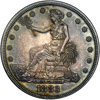 |
1883 Trade Dollar. NGC graded Proof 63. Nice original toning on both sides with light green, dark blue and light gold colors. Only 979 proofs struck for this proof only issue. This is indeed a well toned specimen with pleasing underlying mirror glitter that breathes life into the bold design and highlights. Nicely struck with crisp details aplenty.
Estimated Value $2,200 - 2,400.
View details and enlarged photos
| Realized
$2,185 |
|
|